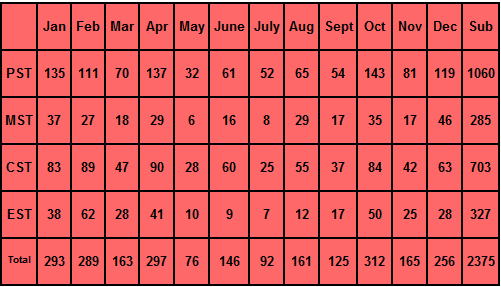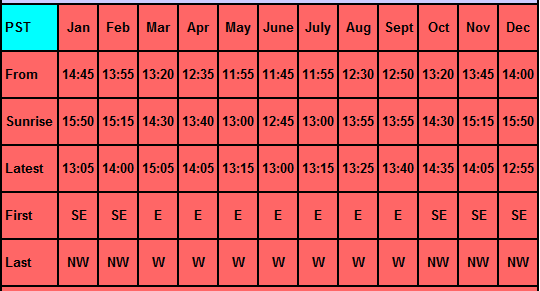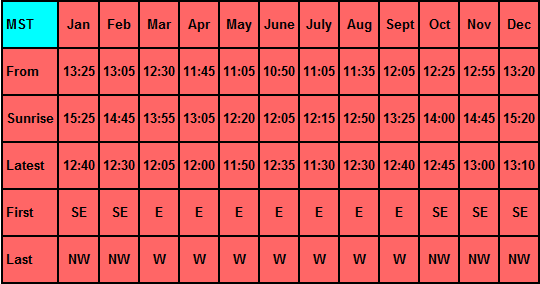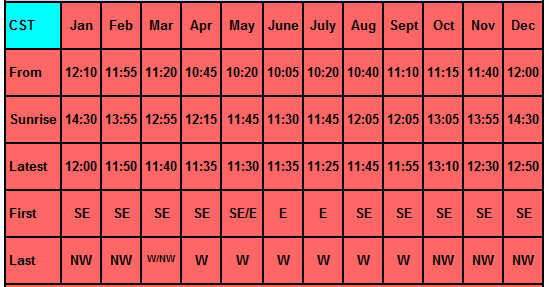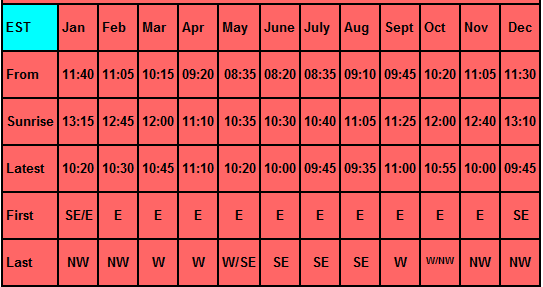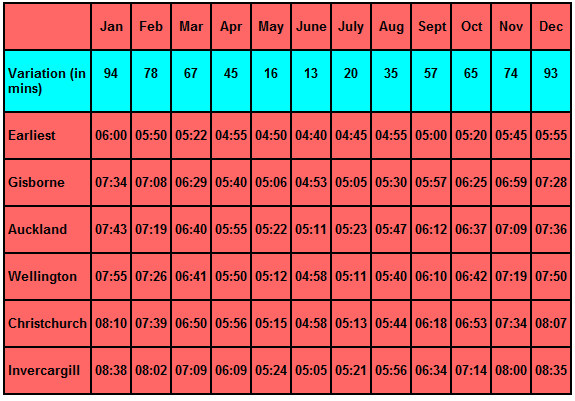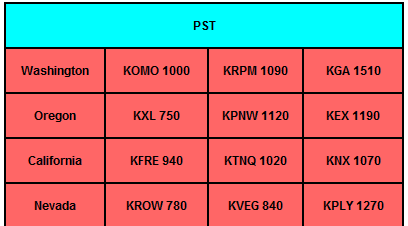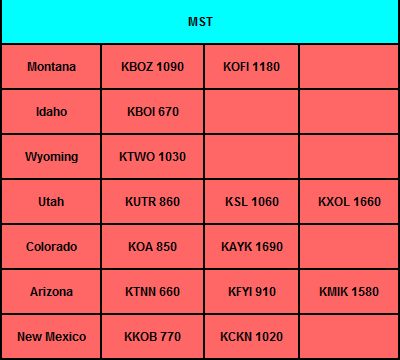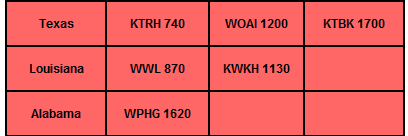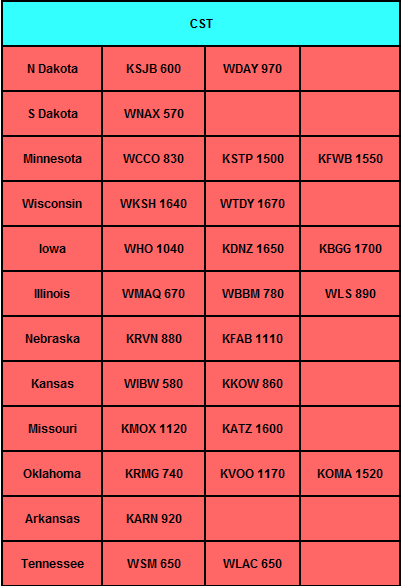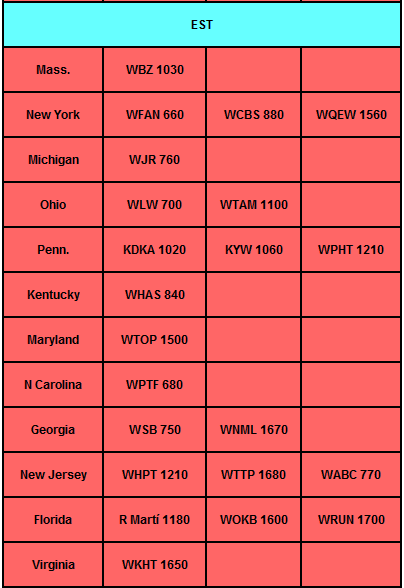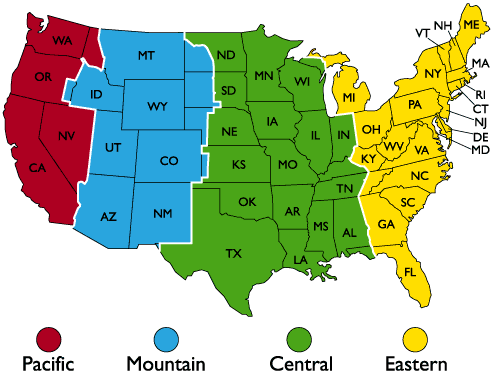DXing stations from the continental USA has given me many hours of satisfactory listening and it’s an aspect of MW DX readily available to New Zealand DXers as we are in one of the best places in the World to take advantage of signals from that part of the Globe… if you’re new to this facet of the hobby, or in need of a recap, or even a bit of incentive… read on!
Part One: The Best Months
A question I’ve been asked on several occasions and one I’ve answered purely on my assumptions over the past 25 years, has been “What’s the best time to hear Americans?”… well, generally speaking in the period preceding our sunset till their sunrise… with enhanced listening around those times, more on that later… let’s deal with the best months first…
I’ve long been an advocate of DXing during the Equinoxes and have heard some really fabulous stuff during late March and late September, enough to make those times of the year my first consideration when planning a DXpedition… however, I have now researched back issues of the DX Times (magazine of the New Zealand Radio DX League) for the past 11 years and come up with the table below which illustrates that, depending on which part of the USA you want to hear, there are months when activity from certain areas is better than others. The table is compiled from all the loggings reported to the MW section of the DX Times… and it took more than a couple of hours to edit! Study these figures, then I’ll make some conclusions… you will note that I have opted to split the USA up into the standard time zones, Pacific (PST), Mountain (MST), Central (CST) and Eastern (EST) in order to make the list less daunting whilst still retaining its usefulness… and you’ll find a map of the USA and its time-zones at the end of the article… many thanks to Alex Krivenyshev of New York for allowing use of his map…
OK… in general the best four months for reception from the USA in order are: October, January, February and April… those Equinox months of March and September have let me down! The best months for reception of PST stations: October, April and January. MST stations: December, January, & October. CST stations: April, February, October & January. EST stations: February, October. You will note that even though the MST zone is closer to New Zealand than the CST and EST zones, there are fewer stations reported. The higher population density and larger geographical area of the other zones account for this. Now, onto the best time, in hours and minutes…
And like all things, it is a matter of timing – quite literally. If you check the Sunset table below (Fig. 3) you will see what time of the day to start DXing, given the month etc… and you can carry on DXing right through the evening until the stations fade-out or until propagation fizzles… see Fig. 2. Reading below you will note that there are two reception lifts, Sunrise and Sunset and things do go a bit flat in between these events, but that is generalising… so stay tuned right across that time-slot! And the earliest time listed below is assuming you’re in a quiet location… electrically quiet that is, where the often weak signals don’t have to contend with local electrical interference. I can be DXing signals at Waianakarua well before they could be heard from home! So, if you can’t hear Americans around the sunset lift, wait an hour or so until total darkness and with luck, you’ll still find some loggable signals… often East-Coasters are best mid-evening… for some reason!
Part Two: Sunrise Lift – a DX Sweet-Spot
As mentioned earlier, there is a very real propagation phenomenon known as “Sunrise Lift”… an enhancement of signals from just prior to sunrise through to twilight at a transmitter location. Many times I’ve experienced stations peaking very strongly, if albeit briefly, before fading very rapidly as Old Man Sol starts his work for the day… even low-powered stations you didn’t even know existed would pop their heads up to be nabbed. The trouble is, most of these lifts occurred either very late at night or early into the morning… some after 3 a.m…. so to maximise sleep-hours and DX, just when should we be listening…
Back when I started DXing from Waianakarua, I hit those sudden peaks more by accident than good planning though had seen such reception reported in the DX Times numerous times before. For some reason, this enhancement seems to favour PST zones the most (which means early-morning stuff as the PST is the last zone to experience sun-rise)… a quick comparison of “Sunrise” and “Latest” times in the tables below illustrates the point. At first it took a fair degree of guess-work to gauge when the sun was rising across the USA, then I heard about a sunrise-sunset protractor called “The DX Edge” which determined these times using a plastic holder with a map of the World printed on it and twelve clear slides, one for each month of the year, which had the sunrise/sunset terminator on them. The idea was to fit the relevant month into the slide, adjust it to the UTC time-scale and Hey Presto! You could see which part of the World was in dark or day and where sunrise/sunset was being experienced at any given time… an invaluable tool for the DXer. Whilst the DX Edge was very useful, it did have some limitations, chiefly as far as the USA goes, there wasn’t a whole lot of detail on the map and it wasn’t always possible to tell exactly when Sunrise would occur at a certain site… and the restriction of scale also made accuracy a problem and when you’re dealing with a window of only around 30 minutes… those factors grew ominously important! So, where do you go for information these days? The Internet…
There are several sources of sunrise/sunset information available though there was one that appealed to me because of its intuitive approach (I hate reading instructions!) and its graphical representation. It’s called “Geoclock” and can be downloaded at www.clark.net/pub/bblake/geoclock – the program is shareware for 30 days and I am seriously considering buying it… Anyway, it made compiling the following charts very easy and has given me plenty of ideas for future articles. (Like the Greyline enhancement mode.. that’s another story and another cold, wet weekend job!).
Rather than compile a huge list with sunrise times for every State, like the Best Month table above, I’ve chosen to use the four time-zones and taken representative samples from each zone then generalised the data to provide something less complex yet still useful. The cities chosen for each zone are, PST: Western/Eureka CA, Northwest /Olympia WA, Southeast/El Centro CA, Eastern/Ely NV. MST: – Western/Boise ID, Northwest/Miles City MT, Southeast/Hobbs NM, Eastern/Scottsbluff NE. CST: Western/Amarillo TX, Northwest/Minot ND, Southeast/Panama City FL, Eastern/St Louis MO. EST: Western/Terre Haute IN, Northwest/Muskegon MI, / Southeast/Miami FL, Eastern/Bangor ME. Some explanation of the data is necessary…
Calculations are based on sunrise on the 15th day of the month.
The times are rounded to the nearest 5 minutes.
There are many approximations as sunrise information wasn’t available for the exact limits of each zone… these times are a guide only.
The “From” time includes a period prior to sunrise as that appears to be when signals start to peak. Therefore, the earliest sunrise in each time-zone is about 30 minutes after the “From” time
“Sunrise” is the last such event in that time-zone.
“Latest” is the latest time a logging was reported in the DX Times… there needs to be more study to make any accurate assumptions about this figure though reception after sunrise only seems likely in the PST zone, and up to 35 minutes… presumably this is the twilight period…
The “First” and “Last” are the regions of the State which experience sunrise in that order… you will note some interesting patterns particularly in the EST times due to Bangor ME being considerably further East than a more central easterly city like Norfolk VA. Nevertheless, I thought it important to include some data from the very North East of the USA as this is an area seldom heard in NZ (with the exception of WBZ Boston MA 1030kHz).
For the study, the sunrise time at 4 locations within each time zone where used, Northwest (NW), Southeast (SE), East (E) & West (W). Some time zones overlap as the States aren’t all neat little squares… for example, West Texas protrudes some distance into the neighbouring MST States so consultation of an Atlas in conjunction with these times would be a good idea.
Whilst the focus of this study has been on the USA, it would be possible to gain an idea of sunset times both North and South of the USA (i.e. Canada & Mexico) by using a piece of string across a globe or ruler laid across a flat map between the study cities… whilst the latter will be inaccurate, it may still give a reasonable indication… and I guess a study of Canadian sunrises won’t be too far away either!
The are a couple of other reasons why good DX occurs around the sunrise-lift, i.e. that stations often change from directional pattern to omnidirectional and/or change from night-power to day power, which can be from under a 100 watts to 50kW! Because of the high number of stations operating on the AM band, at night many stations are restricted to certain transmitter powers and antenna patterns to protect neighbouring stations from interference… however, if a certain station is protecting another station to its East, the FCC often allows them to increase transmitter power and/or change antenna pattern when sunrise occurs at the protected station as the protecting station’s skywave signal will no longer cause any interference.
And I haven’t neglected Alaska or Hawaii… they’re case-studies in themselves…
ALL TIMES UTC/GMT
Part Three: Sunset Lift
And now that we’ve tackled one sunrise enhancement, there is another issue closer to home… that is our sunset, for there is a notable lift in reception conditions, not just from the USA but from anywhere East of here prior to dusk. Again I have researched back issues of the DX Times for the last 11 years (that being the whole period of the Sunspot cycle) and come up with some interesting statistics… most notably that we can experience reception of signals from the USA at loggable strength as early as 94 minutes prior to sunset in the height of Summer, shrinking to 13 minutes in the shortest month. This Variation between earliest reception and earliest sunset is given in minutes at the top of the chart… note that the “twilight” zone is longer in the South of the country than in the North. Pre-sunrise DX is also enhanced by the arrival of signals from the USA before New Zealanders start causing too much havoc…
Fig. 3
Part Four: The “Best Bets”
So far, we’ve worked out what time and what month are best for DXing the USA, knowing which frequencies to tune to is the next logical step… and as you can see in Fig. 1, the PST zone, i.e. the States closest to us, provide the best reception… the following table lists the stations that are most likely to provide candidates for reception though the proximity of your locals and semi-locals to some frequencies will make reception difficult indeed… most of these are 50kW stations and the States not listed I consider very hard to hear… once again, the stations are sorted in Time Zones…
ALL TIMES UTC/GMT
Fig. 4
Given this information, the next question is likely to be “Which direction should my aerials favour?”… and consultation of a Great Circle map based on Wellington, tells us that anywhere between 40º and 80º is the required azimuth. At 40º your aerial will be bearing on Vancouver (Washington State), San Francisco is 46º, Los Angeles 52º, Denver 53º, Chicago 60º, Dallas 64º, New York 66º, Washington DC 68º, New Orleans 70º, and Miami 78º. Don’t forget to allow for the magnetic deviation if you’re using a compass… In general, point your loop, longwire or Beverage in a North-easterly direction.
Good US DX everyone!

